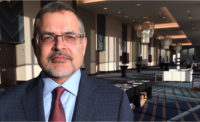
The design community must lead the charge to advance the cause of sustainable energy in pursuit of Architecture 2030 benchmarks, which were established to dramatically reduce fossil-fuel consumption and greenhouse-gas emissions by changing buildings and creating a resilient built environment. To do it, designers must visibly and actively promote the viability of renewables. DLR Group has partnered with NRG Energy to design a series of on-site solar power systems for football stadiums for six National Football League teams. Recently, Levi's Stadium in Santa Clara, Calif., opened as the new home of the San Francisco 49ers, and work is just underway on a solar design at NRG Stadium in Houston Texans.
The design program for NRG showcases, on very public venues, that solar design can manifest itself as more than panels attached to a roof or a simple panel farm in a rural area. These systems integrate solar panels and innovative LED lighting to deliver design that complements and elevates the existing architecture of a facility. This integrated design program illustrates that the application and activation of renewables on existing structures can provide multiple benefits for energy companies, customers and the public.
 |
| MUNN |
More than 7,000 solar panels cover 850 spaces in the stadium's Platinum A1 parking lot and shield VIP fans from the elements. At a NRG-branded entry gate, fans are greeted by the 30-ft-tall Solar Man, a statue of a quarterback poised to heave a long bomb into the end zone. Solar Man is constructed of thin solar cells in an acrylic shell and is part of the working FedExField solar array.
Then, as fans wind their way up scissor-shaped ramps into the seating bowl, 188 bi-facial translucent solar panels preserve views to the outside of the stadium, and 525 conventional glass panels form the remainder of the array. At night, LEDs in the glass-panel wall create a brilliantly colored light show.
The FedExField array allows NRG, the Washington Redskins and the NFL to take a visible advocacy position for sustainability and renewable energy. And through sponsorships, stadium-branded graphics and information kiosks to educate fans about the on-site renewable system, NRG also benefits from a positive brand experience with fans, who are, ultimately, NRG customers.
The Levi's Stadium design features the NRG Solar Terrace on the suite deck's roof and three NRG "energy bridges" enclosed with solar panels. Again, all these elements convey NRG's commitment to a future of renewable- energy production.
Dynamic on-site renewable systems can be incorporated into the architecture of both existing buildings and new construction. This approach can be the next step toward a future of clean, sustainable energy. As always, design is a key to affecting change. We just have to be brave and lead the process.
Dan Munn, P.E., S.E, LEED AP, is a senior principal and U.S. engineering leader for DLR Group. He can be reached by email at dmunn@dlrgroup.com.
The first solar power system design to come on line was at FedExField in Landover, Md., in 2011. An 8,000-panel (2 MW) photovoltaic energy-generating system provides 20% of the stadium's power needs on Washington Redskins game days. On non-event days, the array can supply all the stadium's power.



Post a comment to this article
Report Abusive Comment